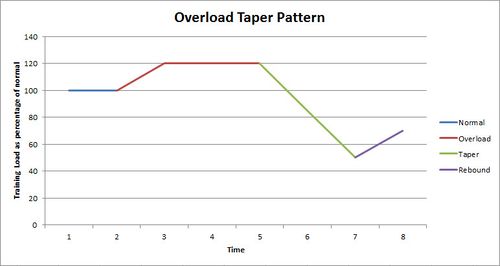Three Phase Taper (AKA Overload Taper)
A three phase taper, sometimes called an overload taper, is a technique that has been shown to have greater benefits than the traditional single phase taper. There is less experience with the three phase taper, so this should be considered a higher risk approach for experienced athletes.
Contents
1 The Three Phases
This style of taper is constructed from three phases; overload, reduction, and rebound.
1.1 Overload
The Overload phase consists of an increased training load, typically 20% more. This period has to be kept fairly short to prevent Overtraining, typically 1-3 weeks. The level of Overload will depend on how intense the normal training load is. A runner who is already training near their maximum capability would want to Overload for a shorter time than a runner who has more training headroom. Many training plans tend to have the peak training load towards the end of the program, but often the peak is a little too early and too minor to be considered an Overload period. (See A Comparison of Marathon Training Plans.)
1.2 Reduction
This phase is the same as the traditional taper, with reduced training load. Typically a greater reduction in training load for a shorter period is used with a three phase taper than with a traditional single phase taper.
1.3 Rebound
The rebound is a short increase in training load, just before competition. This approach was developed from the observation that some athletes in multiday competitions such as track races have their performance improve as the heats progress. How much the training load should be increased is not well defined, but the general idea is to focus on increased intensity with a moderate uptick in volume. The rebound should be in the last few days before competition.
2 Personal experience
Because I was pacing the 2011 Thunder Road Marathon, I decided to experiment with a Three Phase Taper. Given this was not a major race, I decided on a short taper of two weeks. I did a one-week overload, followed by a four day decay, and a one day rebound. My weekly mileage leading up to the three phase taper was 114, 108, 102, 150, 140. Therefore I targeted to a 20% overload based on a 140 mile per week giving me a ~170 mile target. The details of each day's training are shown on the table below. The overload was extremely tough and towards the end of is unable to maintain the required mileage to hit my target. The first day of the decay period I was hoping to cover 16 miles at marathon pace, but I was too tired off to the overload and could only maintain marathon pace for 11 miles. The next three days constituted a very short exponential decay taper, and the day before the race was a single day rebound up to 6 miles. The day before the race also included some carbohydrate loading which resulted in weight gain of approximately 3 1/2 pounds.
2.1 Training details
|
Date |
Mileage |
Pace |
Notes |
|
Monday, October 31, 2011
|
24
|
8:02 |
Aiming for ~8:00 pace and feeling okay |
|
Tuesday, November 01, 2011
|
24
|
8:07 |
Aiming for ~8:00 pace and feeling okay |
|
Wednesday, November 02, 2011
|
25
|
7:59 |
Aiming for ~8:00 pace and feeling okay |
|
Thursday, November 03, 2011
|
24
|
8:36 |
Too much fatigue for 8:00 pace |
|
Friday, November 04, 2011
|
23
|
8:31 |
Fatigue hit badly later in the run |
|
Saturday, November 05, 2011
|
25
|
8:43 |
Aimed for a slower pace, as fatigue is too great |
|
Sunday, November 06, 2011
|
21
|
8:36 |
Intended to run 25, but too tired |
|
Monday, November 07, 2011
|
11
|
6:58 |
Target MP of ~6:50, but a little too slow and terminated the run when the pace dropped too far |
|
Tuesday, November 08, 2011
|
13
|
6:40 |
Legs bouncing back |
|
Wednesday, November 09, 2011
|
7.5
|
6:44 |
|
|
Thursday, November 10, 2011
|
3
|
6:51 |
Shortest run of the decay period, not really even warming up |
|
Friday, November 11, 2011
|
6
|
6:50 |
A slight rebound, increasing miles to 6. Carbohydrate loading for one day. |
|
Saturday, November 12, 2011
|
35 |
7:00 |
Pace Thunder Road Marathon, 3:02 for the marathon, plus extra 9 miles. |
2.2 Conclusion
A two-week period was too short to work well. A one-week overload seem to be quite effective but I don't think I could've tolerated much more. However the fatigue from that one-week overload was too great to recover in just six days. That said, I found much better prepared for pacing the race than I expected. Maintaining marathon pace throughout the decay and rebound worked remarkably well and I felt very comfortable that pace during the race. The carbohydrate loading was especially successful as I've maintained a low carbohydrate diet until the day before the race. Next time around I will follow a similar pattern, but I will allow a longer decay period.
